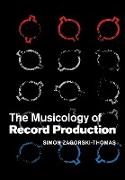Read more
Simon Zagorski-Thomas sets out a framework for the study of record production using current ideas from psychology and sociology.
List of contents
1. Introduction; 2. Why study record production?; 3. How should we study record production?; Theoretical interlude 1; 4. Sonic cartoons; 5. Staging; Theoretical interlude 2; 6. The development of audio technology; 7. Using technology; Theoretical interlude 3; 8. Training, communication and practice; 9. Performance in the studio; Theoretical interlude 4; 10. Aesthetics and consumer influence; 11. The business of record production; Afterword.
About the author
Simon Zagorski-Thomas is a Reader at the London College of Music, University of West London. He is a director of the annual Art of Record Production Conference, a co-founder of the Journal on the Art of Record Production and co-chairman of the Association for the Study of the Art of Record Production (www.artofrecordproduction.com). His publications include The Art of Record Production (co-edited with Simon Frith, 2012). Before becoming an academic he worked for twenty-five years as a composer, sound engineer and producer with artists as varied as Phil Collins, Mica Paris, the London Community Gospel Choir, Bill Bruford, The Mock Turtles, Courtney Pine and the Balanescu Quartet. He continues to compose and record music and is currently conducting research into the musicology of record production, popular music analysis and performance practice in the recording process.
Summary
Recorded music is as different to live music as film is to theatre. In this book, Simon Zagorski-Thomas sets out a framework for the study of recorded music and record production using current ideas from psychology and sociology.

